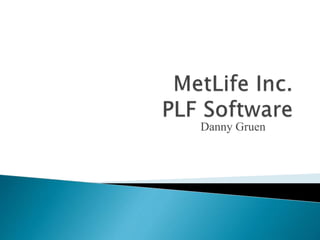
FInal MetLife Powerpoint Presentation[1]
- 1. Danny Gruen
- 2. PLF (Personal Learning Finance) Programmed in SQL Specific for PC ◦ Mac coming soon...
- 3. Product: ◦ PLF – Program for end-user to analyze and predict personal financial decisions Objectives ◦ Maximize profit ◦ Use market data to create demand, revenue, cost and profit functions ◦ Use the functions to find the optimal price at which to produce and sell and at the maximum profit ◦ See how changes in cost, price, and demand affect profit
- 4. Demand is a quadratic function Our market data given is accurate Our product is in a monopoly market
- 5. Demand ◦ D(q) : price per unit (dependent on q) ◦ q: number of units sold Revenue ◦ R(q): quantity multiplied by price per unit ◦ R(q) = q x D(q) Cost ◦ C(q): comprised of two components → fixed cost (constant) and variable cost (dependent on q) ◦ C(q) = Fixed Cost + VC(q) Profit ◦ P(q): revenue minus total cost ◦ P(q) = R(q) – C(q)
- 6. Marginal Profit ◦ MP(q): Profit generated from extra unit sold; MP(q) = MR(q) – MC(q) Marginal Cost ◦ MC(q) = Cost incurred for producing the extra unit; MC(q) = C’(q) Marginal Revenue ◦ MR(q): The revenue generated from one extra unit sold ◦ MR(q) = R’(q)
- 8. - Our demand graph is a graphical representation of the quadratic demand function through plotting the market data points K’s
- 9. •R(q) = D(q) x q •R(q) =-.0002605115x3-.0503324462x2+568.7833351581x •Peak of graph is Max Revenue
- 10. Derivative of Revenue graph •Where graph crosses x-axis this is our max revenue
- 11. The cost graph depicts the sum of the fixed and variable costs at different quantities or levels of production Cost Function: C(q) = Fixed cost +variable cost 13848001670124. 8005001420155. 5000850270. )( qq qq qq qC
- 12. •Derivative of Cost function
- 13. •The points where the two graphs meet are the break even points, where the profit = 0, and when revenue = cost •The maximum profit is represented by the greatest distance between the revenue and cost
- 14. P(q) = R(q) – C(q); MP(q) = MR(q) – MC(q) The profit graphs shows the relationship between the number of units sold and the profit earned at these various quantities The maximum profit is $34.30 million at 666,000 procedures.
- 15. Where the graph crosses the x- axis is where we achieve max profit
- 16. Max Profit occurs where MC(q) = MR(q) MR(q) = MC(q) at q=666
- 17. What is the optimal price to set our product at? ◦ We determined that our optimal price would be $419.68 How many pills can we sell at this price? ◦ We determined that we could sell 666,000 pills What is the maximum profit? ◦ Maximum profit = $34.30 million
- 18. We must find the revenue at the profit maximizing point: ◦ R(q) = optimal price x expected quantity sold at maximum price = $419.68 x 666= $279.54 million Subtract total possible revenue from the revenue at profit maximizing point: ◦ Consumer Surplus: )666*419(78333.56805033.00026. .666 0 2 dxxx =195548725.06
- 19. A 1% decrease in demand yields: •Optimal price of $419.20 •Quantity of 961.06?? •Profit would decrease by $10 thousand •Total profit of $34.29 million
- 20. A 2% increase in marginal cost yields: Optimal price of $419.68 Quantity of 666 thousand Decreased the profit by $7.03 million total profit of $25.99 million
- 22. Questions?